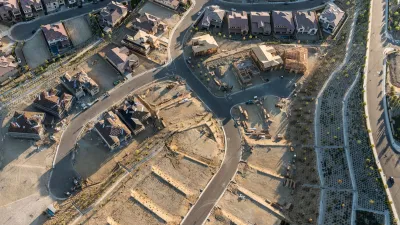In 2006, the Los Angeles Planning Dept. launched an urban design studio to turn Los Angeles into a more pedestrian-friendly city. The studio has gone on to create a set of walkability guidelines, and has more ambitious goals ahead.
Tibby Rothman of The Architect's Newspaper sat down with planners Emily Gabel-Luddy, and Simon Pastucha from the Urban Design Studio. They talked about the Studio's 11 Urban Design Principles, which are a set of values to which developers would be required to subscribe when seeking entitlements.
"AN: The truth underlying the Urban Design Principles is that all the great cities of the world came into being based on the human scale and prior to the advent of automobiles, and it's the design studio's intent to focus back to the human scale. Give me a practical example of what sort of implementation that might entail.
Emily Gabel-Luddy: Let me go to the Street Standards in Downtown Los Angeles. It was our goal that the city move away from an auto-centric proposition to one that emphasizes the pedestrian and mass transit. And so we spearheaded the idea of 15-foot-minimum-wide sidewalks in the dense urban core of our city. The reason this is so significant is because it lets all the developers and property owners have so much more room to put their outdoor café accessories-their tables and chairs-which in turn begins to cultivate the kind of social commerce among neighborhoods, residents, and office workers that was really part of cities prior to the automobile playing such an overriding part in how the public realm is defined and utilized.
AN: How will the Urban Design Principles dovetail into existing neighborhood plans? Don't architects have enough regulations on their plate already?
Simon Pastucha: Both the Urban Design Principles and the Downtown Design Standards are set up as a set of ideas to incorporate into your design. They're not a set of standard requirements saying that you have to have ‘this' at a certain point or a certain place. They just say: How do you meet the intent of these?
EGL: It's not a design review, it's not an ordinance. It says: Here's the value, now tell us how your project has achieved that value. I don't think true design comes from telling architects how to design their buildings. True design comes from having the architect reflect on how that building achieves value that is expressed in a way that is appropriate to a local community."
FULL STORY: Q&A: LA Urban Design Studio

Manufactured Crisis: Losing the Nation’s Largest Source of Unsubsidized Affordable Housing
Manufactured housing communities have long been an affordable housing option for millions of people living in the U.S., but that affordability is disappearing rapidly. How did we get here?

Americans May Be Stuck — But Why?
Americans are moving a lot less than they once did, and that is a problem. While Yoni Applebaum, in his highly-publicized article Stuck, gets the reasons badly wrong, it's still important to ask: why are we moving so much less than before?

Research Shows More Roads = More Driving
A national study shows, once again, that increasing road supply induces additional vehicle travel, particularly over the long run.

Judge Halts Enforcement of Anti-Homeless Laws in Grants Pass
The Oregon city will be barred from enforcing two ordinances that prosecute unhoused residents until it increases capacity and accessibility at designated camping sites.

Advancing Sustainability in Los Angeles County Schools
The Los Angeles County Office of Education’s Green Schools Symposium brings together educators, students, and experts to advance sustainability in schools through innovative design, climate resilience strategies, and collaborative learning.

Using Old Oil and Gas Wells for Green Energy Storage
Penn State researchers have found that repurposing abandoned oil and gas wells for geothermal-assisted compressed-air energy storage can boost efficiency, reduce environmental risks, and support clean energy and job transitions.
Urban Design for Planners 1: Software Tools
This six-course series explores essential urban design concepts using open source software and equips planners with the tools they need to participate fully in the urban design process.
Planning for Universal Design
Learn the tools for implementing Universal Design in planning regulations.
City of Moreno Valley
Institute for Housing and Urban Development Studies (IHS)
City of Grandview
Harvard GSD Executive Education
NYU Wagner Graduate School of Public Service
City of Cambridge, Maryland
Newport County Development Council: Connect Greater Newport





























